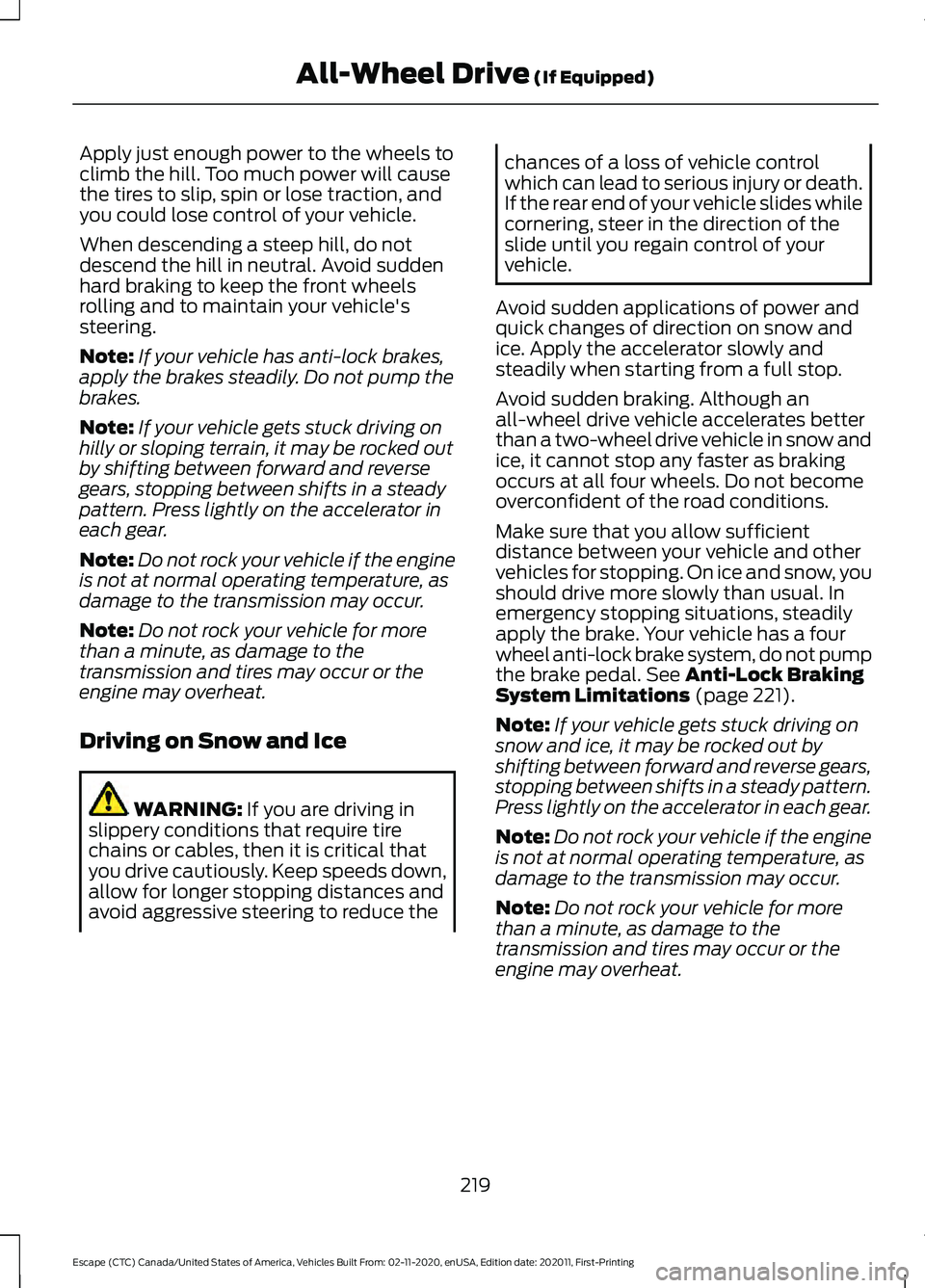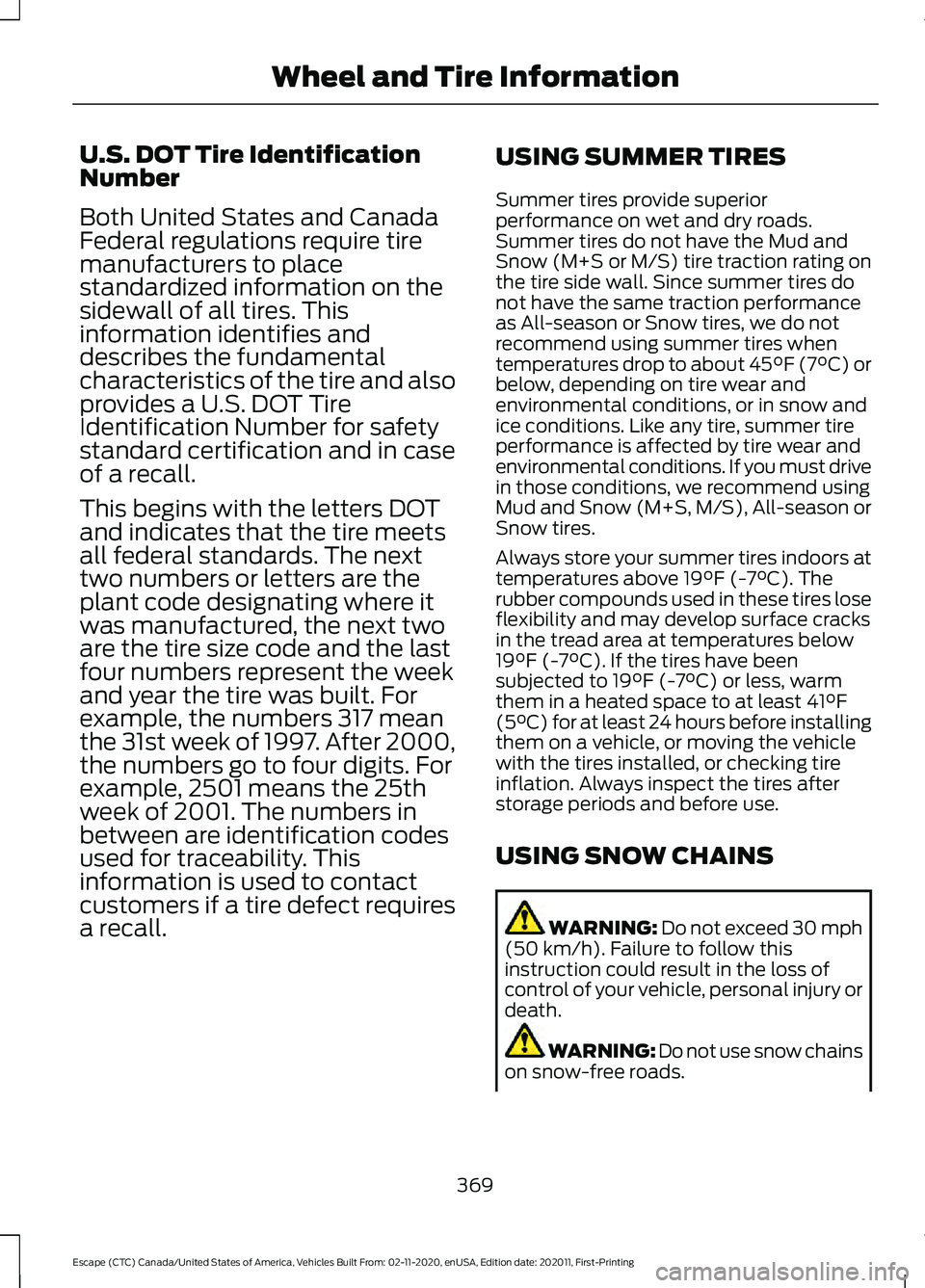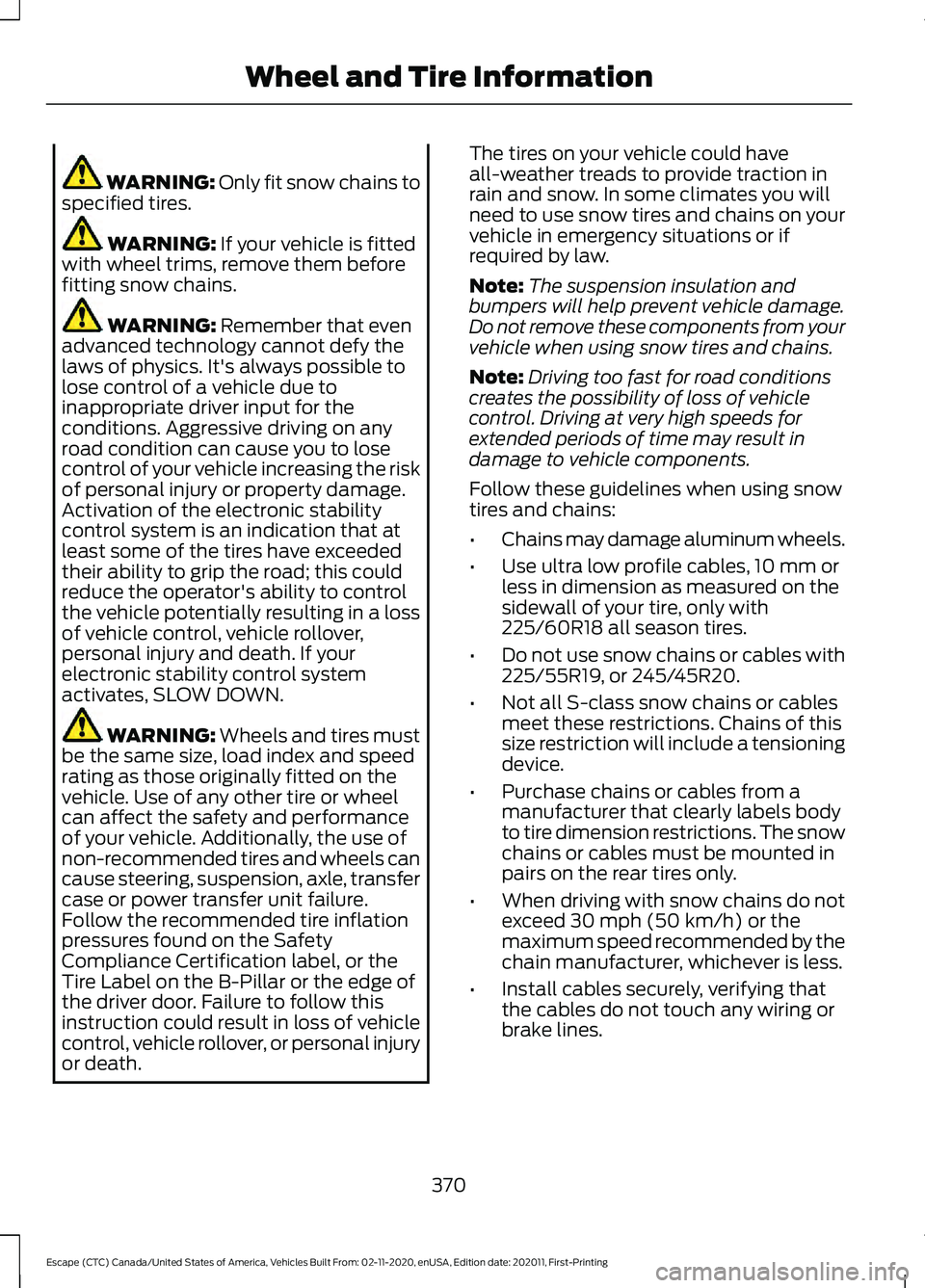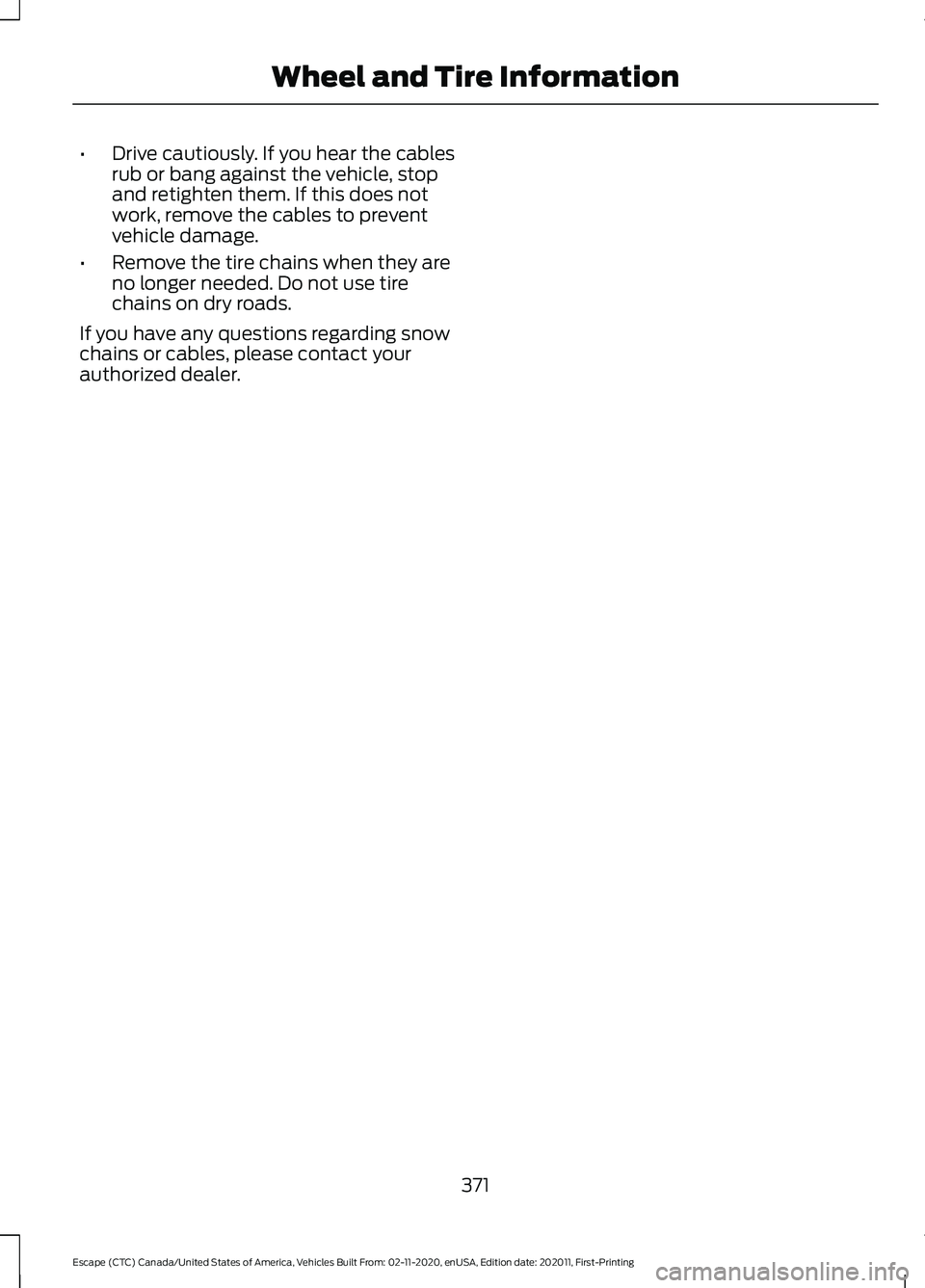2021 FORD ESCAPE snow chains
[x] Cancel search: snow chainsPage 15 of 589

Tire Replacement Requirements
..........367
Using Summer Tires ..................................
369
Using Snow Chains ....................................
369
Tire Care
Checking the Tire Pressures ....................
372
Inflating the Tires ........................................
372
Inspecting the Tire for Wear ....................
373
Inspecting the Tire for Damage .............
373
Inspecting the Wheel Valve Stems ......
374
Tire Rotation .................................................
374
Tire Sealant and Inflator Kit
What Is the Tire Sealant and Inflator Kit ........................................................................\
376
Tire Sealant and Inflator Kit Precautions ........................................................................\
376
Locating the Tire Sealant and Inflator Kit ........................................................................\
376
Tire Sealant and Inflator Kit Components ........................................................................\
.
377
Using the Tire Sealant and Inflator Kit ........................................................................\
.
377
Tire Pressure Monitoring System
What Is the Tire Pressure Monitoring System ........................................................
382
Tire Pressure Monitoring System Overview ....................................................
382
Tire Pressure Monitoring System Precautions ...............................................
383
Tire Pressure Monitoring System Limitations ................................................
383
Viewing the Tire Pressures .....................
384
Tire Pressure Monitoring System – Troubleshooting .....................................
384
Changing a Road Wheel
Changing a Flat Tire ..................................
386
Wheel Nuts ...................................................
390Capacities and Specifications
Engine Specifications - 1.5L EcoBoost™
........................................................................\
.
391
Engine Specifications - 2.0L EcoBoost™ ........................................................................\
392
Engine Specifications - 2.5L, Hybrid Electric Vehicle (HEV)/Plug-In Hybrid
Electric Vehicle (PHEV) .......................
393
Motorcraft Parts - 1.5L EcoBoost™ ......
394
Motorcraft Parts - 2.0L EcoBoost™ ....
394
Motorcraft Parts - 2.5L, Hybrid Electric Vehicle (HEV)/Plug-In Hybrid Electric
Vehicle (PHEV) .......................................
395
Engine Oil Capacity and Specification - 1.5L EcoBoost™ ......................................
396
Engine Oil Capacity and Specification - 2.0L EcoBoost™ .....................................
397
Engine Oil Capacity and Specification - 2.5L, Hybrid Electric Vehicle (HEV)/
Plug-In Hybrid Electric Vehicle (PHEV)
.......................................................................
399
Cooling System Capacity and Specification - 1.5L EcoBoost™ .......
400
Cooling System Capacity and Specification - 2.0L EcoBoost™ .......
401
Cooling System Capacity and Specification - 2.5L, Hybrid Electric
Vehicle (HEV)/Plug-In Hybrid Electric
Vehicle (PHEV) ........................................
401
Fuel Tank Capacity - Excluding: Hybrid Electric Vehicle (HEV)/Plug-In Hybrid
Electric Vehicle (PHEV) .......................
402
Fuel Tank Capacity - Hybrid Electric Vehicle (HEV)/Plug-In Hybrid Electric
Vehicle (PHEV) .......................................
403
Air Conditioning System Capacity and Specification - 1.5L EcoBoost™ .......
404
Air Conditioning System Capacity and Specification - 2.0L EcoBoost™ ......
405
Air Conditioning System Capacity and Specification - 2.5L, Hybrid Electric
Vehicle (HEV)/Plug-In Hybrid Electric
Vehicle (PHEV) ......................................
406
Washer Fluid Specification ....................
406
12
Escape (CTC) Canada/United States of America, Vehicles Built From: 02-11-2020, enUSA, Edition date: 202011, First-Printing Table of Contents
Page 222 of 589

Apply just enough power to the wheels to
climb the hill. Too much power will cause
the tires to slip, spin or lose traction, and
you could lose control of your vehicle.
When descending a steep hill, do not
descend the hill in neutral. Avoid sudden
hard braking to keep the front wheels
rolling and to maintain your vehicle's
steering.
Note:
If your vehicle has anti-lock brakes,
apply the brakes steadily. Do not pump the
brakes.
Note: If your vehicle gets stuck driving on
hilly or sloping terrain, it may be rocked out
by shifting between forward and reverse
gears, stopping between shifts in a steady
pattern. Press lightly on the accelerator in
each gear.
Note: Do not rock your vehicle if the engine
is not at normal operating temperature, as
damage to the transmission may occur.
Note: Do not rock your vehicle for more
than a minute, as damage to the
transmission and tires may occur or the
engine may overheat.
Driving on Snow and Ice WARNING: If you are driving in
slippery conditions that require tire
chains or cables, then it is critical that
you drive cautiously. Keep speeds down,
allow for longer stopping distances and
avoid aggressive steering to reduce the chances of a loss of vehicle control
which can lead to serious injury or death.
If the rear end of your vehicle slides while
cornering, steer in the direction of the
slide until you regain control of your
vehicle.
Avoid sudden applications of power and
quick changes of direction on snow and
ice. Apply the accelerator slowly and
steadily when starting from a full stop.
Avoid sudden braking. Although an
all-wheel drive vehicle accelerates better
than a two-wheel drive vehicle in snow and
ice, it cannot stop any faster as braking
occurs at all four wheels. Do not become
overconfident of the road conditions.
Make sure that you allow sufficient
distance between your vehicle and other
vehicles for stopping. On ice and snow, you
should drive more slowly than usual. In
emergency stopping situations, steadily
apply the brake. Your vehicle has a four
wheel anti-lock brake system, do not pump
the brake pedal.
See Anti-Lock Braking
System Limitations (page 221).
Note: If your vehicle gets stuck driving on
snow and ice, it may be rocked out by
shifting between forward and reverse gears,
stopping between shifts in a steady pattern.
Press lightly on the accelerator in each gear.
Note: Do not rock your vehicle if the engine
is not at normal operating temperature, as
damage to the transmission may occur.
Note: Do not rock your vehicle for more
than a minute, as damage to the
transmission and tires may occur or the
engine may overheat.
219
Escape (CTC) Canada/United States of America, Vehicles Built From: 02-11-2020, enUSA, Edition date: 202011, First-Printing All-Wheel Drive
(If Equipped)
Page 372 of 589

U.S. DOT Tire Identification
Number
Both United States and Canada
Federal regulations require tire
manufacturers to place
standardized information on the
sidewall of all tires. This
information identifies and
describes the fundamental
characteristics of the tire and also
provides a U.S. DOT Tire
Identification Number for safety
standard certification and in case
of a recall.
This begins with the letters DOT
and indicates that the tire meets
all federal standards. The next
two numbers or letters are the
plant code designating where it
was manufactured, the next two
are the tire size code and the last
four numbers represent the week
and year the tire was built. For
example, the numbers 317 mean
the 31st week of 1997. After 2000,
the numbers go to four digits. For
example, 2501 means the 25th
week of 2001. The numbers in
between are identification codes
used for traceability. This
information is used to contact
customers if a tire defect requires
a recall.
USING SUMMER TIRES
Summer tires provide superior
performance on wet and dry roads.
Summer tires do not have the Mud and
Snow (M+S or M/S) tire traction rating on
the tire side wall. Since summer tires do
not have the same traction performance
as All-season or Snow tires, we do not
recommend using summer tires when
temperatures drop to about 45°F (7°C) or
below, depending on tire wear and
environmental conditions, or in snow and
ice conditions. Like any tire, summer tire
performance is affected by tire wear and
environmental conditions. If you must drive
in those conditions, we recommend using
Mud and Snow (M+S, M/S), All-season or
Snow tires.
Always store your summer tires indoors at
temperatures above 19°F (-7°C). The
rubber compounds used in these tires lose
flexibility and may develop surface cracks
in the tread area at temperatures below
19°F (-7°C)
. If the tires have been
subjected to 19°F (-7°C) or less, warm
them in a heated space to at least 41°F
(5°C) for at least 24 hours before installing
them on a vehicle, or moving the vehicle
with the tires installed, or checking tire
inflation. Always inspect the tires after
storage periods and before use.
USING SNOW CHAINS WARNING: Do not exceed 30 mph
(50 km/h)
. Failure to follow this
instruction could result in the loss of
control of your vehicle, personal injury or
death. WARNING:
Do not use snow chains
on snow-free roads.
369
Escape (CTC) Canada/United States of America, Vehicles Built From: 02-11-2020, enUSA, Edition date: 202011, First-Printing Wheel and Tire Information
Page 373 of 589

WARNING: Only fit snow chains to
specified tires. WARNING:
If your vehicle is fitted
with wheel trims, remove them before
fitting snow chains. WARNING:
Remember that even
advanced technology cannot defy the
laws of physics. It's always possible to
lose control of a vehicle due to
inappropriate driver input for the
conditions. Aggressive driving on any
road condition can cause you to lose
control of your vehicle increasing the risk
of personal injury or property damage.
Activation of the electronic stability
control system is an indication that at
least some of the tires have exceeded
their ability to grip the road; this could
reduce the operator's ability to control
the vehicle potentially resulting in a loss
of vehicle control, vehicle rollover,
personal injury and death. If your
electronic stability control system
activates, SLOW DOWN. WARNING:
Wheels and tires must
be the same size, load index and speed
rating as those originally fitted on the
vehicle. Use of any other tire or wheel
can affect the safety and performance
of your vehicle. Additionally, the use of
non-recommended tires and wheels can
cause steering, suspension, axle, transfer
case or power transfer unit failure.
Follow the recommended tire inflation
pressures found on the Safety
Compliance Certification label, or the
Tire Label on the B-Pillar or the edge of
the driver door. Failure to follow this
instruction could result in loss of vehicle
control, vehicle rollover, or personal injury
or death. The tires on your vehicle could have
all-weather treads to provide traction in
rain and snow. In some climates you will
need to use snow tires and chains on your
vehicle in emergency situations or if
required by law.
Note:
The suspension insulation and
bumpers will help prevent vehicle damage.
Do not remove these components from your
vehicle when using snow tires and chains.
Note: Driving too fast for road conditions
creates the possibility of loss of vehicle
control. Driving at very high speeds for
extended periods of time may result in
damage to vehicle components.
Follow these guidelines when using snow
tires and chains:
• Chains may damage aluminum wheels.
• Use ultra low profile cables, 10 mm or
less in dimension as measured on the
sidewall of your tire, only with
225/60R18 all season tires.
• Do not use snow chains or cables with
225/55R19, or 245/45R20.
• Not all S-class snow chains or cables
meet these restrictions. Chains of this
size restriction will include a tensioning
device.
• Purchase chains or cables from a
manufacturer that clearly labels body
to tire dimension restrictions. The snow
chains or cables must be mounted in
pairs on the rear tires only.
• When driving with snow chains do not
exceed
30 mph (50 km/h) or the
maximum speed recommended by the
chain manufacturer, whichever is less.
• Install cables securely, verifying that
the cables do not touch any wiring or
brake lines.
370
Escape (CTC) Canada/United States of America, Vehicles Built From: 02-11-2020, enUSA, Edition date: 202011, First-Printing Wheel and Tire Information
Page 374 of 589

•
Drive cautiously. If you hear the cables
rub or bang against the vehicle, stop
and retighten them. If this does not
work, remove the cables to prevent
vehicle damage.
• Remove the tire chains when they are
no longer needed. Do not use tire
chains on dry roads.
If you have any questions regarding snow
chains or cables, please contact your
authorized dealer.
371
Escape (CTC) Canada/United States of America, Vehicles Built From: 02-11-2020, enUSA, Edition date: 202011, First-Printing Wheel and Tire Information
Page 587 of 589

Traction Control...........................................229
Traction Control – Troubleshooting...........229
Traction Control – Troubleshooting........................................229
Traction Control – Information Messages......................................................... 230
Traction Control – Warning Lamps.............229
Trailer Brake Precautions
.........................303
Trailer Sway Control Precautions...........310
Trailer Sway Control
....................................310
Trailer Towing Hints....................................304
Transporting the Vehicle............................319
Trip Computer
................................................129
Trip Data..........................................................130
This Trip.................................................................. 130
Trip 1 and 2............................................................ 130
U
Under Hood Fuse Box................................324 Accessing the Under Hood Fuse Box.........324
Identifying the Fuses in the Under Hood
Fuse Box........................................................... 325
Locating the Under Hood Fuse Box............324
Under Hood Overview - 1.5L EcoBoost™.................................................335
Under Hood Overview - 2.0L EcoBoost™.................................................336
Under Hood Overview - 2.5L, Hybrid Electric Vehicle (HEV)/Plug-In Hybrid
Electric Vehicle (PHEV)..........................337
USB Ports
........................................................166
Using Auto Hold...........................................228
Using MyKey With Remote Start Systems..........................................................66
Using Snow Chains.....................................369
Using Summer Tires...................................369
Using SYNC™ With Your Media Player............................................................426
Audio Voice Commands.................................. 427
Media Sources.................................................... 426
Using SYNC™ With Your Phone............422 Accessing Features through the Phone
Menu.................................................................. 423
Pairing a Phone................................................... 422
Phone Controls................................................... 423
Phone Voice Commands................................ 422Using the Instrument Cluster Display
Controls.........................................................123
Button......................................................................\
123
Return Button....................................................... 123
Status Indicator................................................... 123
Toggle Buttons..................................................... 123
Using the Remote Control
..........................58
Liftgate..................................................................... 58
Lock........................................................................\
... 58
Panic Alarm............................................................ 58
Remote Start......................................................... 58
Unlock...................................................................... 58
Using the Tire Sealant and Inflator Kit....................................................................377
First Stage: Reinflating the Tire with sealing compound and air........................................ 378
Second Stage: Checking the tire pressure with the inflator kit...................................... 380
Tips for use of the kit......................................... 377
What to do after the tire has been sealed............................................................... 380
What to do when a tire is punctured...........377
Using This Publication..................................18
Using Voice Recognition
...........................420
Audio Voice Commands................................. 439
Climate Voice Commands............................ 440
Initiating a Voice Session................................ 420
Mobile App Voice Commands...................... 443
Navigation Voice Commands....................... 442
Phone Voice Commands............................... 440
SiriusXM Traffic and Travel Link Voice Commands..................................................... 444
System Interaction and Feedback...............421
Voice Settings Commands............................ 444
V
Vehicle Care
...................................................352
Cleaning the Exterior........................................ 352
Cleaning the Interior......................................... 354
Vehicle Charging Status - Plug-In Hybrid Electric Vehicle (PHEV)..........................128
Vehicle Identification Number
...............408
Locating the Vehicle Identification
Number............................................................ 408
Vehicle Identification Number Overview......................................................... 408
584
Escape (CTC) Canada/United States of America, Vehicles Built From: 02-11-2020, enUSA, Edition date: 202011, First-Printing Index